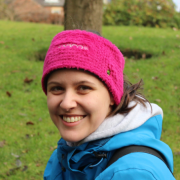Ruth Irovec
School of Biosciences
Research Student
Thesis - Bronze and Iron Age sites in the Eastern Alpine Area with special focus on mining and smelting contexts: a zooarchaeological approach (working title)


Full contact details
School of Biosciences
Minalloy House
10-16 Regent Street
Sheffield
S1 3NJ
- Qualifications
-
2020-present – PhD Candidate – Department of Archaeology, The University of Sheffield
2017-1018 – MSc Osteoarchaeology – The University of Sheffield (distinction)
2013-2017 – MA Archaeology – University of Innsbruck
2010-2013 – BA Archaeology – University of Innsbruck
- Research interests
-
Thesis - Bronze and Iron Age sites in the Eastern Alpine Area with special focus on mining and smelting contexts: a zooarchaeological approach (working title)
Supervisors: Professor Umberto Albarella & Professor Bob Johnston
Thesis Abstract
Numerous Bronze and Iron Age sites have been located in the Eastern Alps in the past decades. While a large amount has been identified as settlements, some sites were entangled with mining of salt or ore as well as smelting activities.
Past zooarchaeological studies provided valuable insights into contemporary animal husbandry and subsistence strategies, not only for settlements, but also for mining and smelting contexts.
Evidence for a well organised society was uncovered at mining and smelting sites where large quantities of meat-bearing skeletal elements with standardised butchery marks were recovered. Many of these sites are in difficult to reach alpine terrain where animal husbandry is unfeasible or even impossible, making an elaborate provisioning system essential, thus hinting at a well organised and far stretching society. Further, there are signs that pig (Sus domesticus) was the preferred species for supplying meat to these metallurgical contexts during the Bronze Age. In contrast, cattle (Bos taurus) and sheep/goat (Ovis aries/ Capra hircus) seem to be predominant at Iron Age sites connected to mining and smelting.
To investigate these patterns further and to assess a potential shift in meat consumption in prehistoric times this project focusses on recording faunal remains retrieved from the recently excavated prehistoric site in Kundl (Austria). The contexts in Kundl date to both, the Bronze Age and Iron Age. Further, this site was not only subject to settlement activity as extensive smelting contexts were also uncovered. Therefore, the faunal remains bear a unique potential. In connection to an extensive literature review and the assessment of smaller assemblages from other contemporary sites this project aims at understanding how subsistence strategies in mining and smelting sites varied from domestic sites during the Bronze and Iron Age in the Eastern Alps and what role the animals played in these different contexts.
- Grants
-
2021 - DOC-team fellowship (ÖAW – Austrian Academy of Sciences)
- Professional activities and memberships
-
Fieldwork
Selection of Excavations:
2021 Höchst (Austria)
2020 Hard (Austria)
2012-2018 Monte Iato (Italy)
2012 Bregenz (Austria)
2009 Bregenz (Austria)
2004-2007 Brederis, Rankweil (Austria)
- Publications
Wimmer, B. & Irovec, R., (2022). Die Tierknochen aus den archäologischen Grabungen Schaan, St. Peter-Platz. Archäologie in Liechtenstein. 2021, 131-160.
Irovec, R., (2022). Terra Sigillata. In: J. Rabitsch, Sechs Häuser und ein Tempel. Ein Beitrag zur Siedlungsgeschichte von Brigantium/Bregenz. Oppenheim am Rhein: Nünnerich-Asmus Verlag. pp. 136-169.
Irovec, R., (2022). Lavezfunde. In: J. Rabitsch, Sechs Häuser und ein Tempel. Ein Beitrag zur Siedlungsgeschichte von Brigantium/Bregenz. Oppenheim am Rhein: Nünnerich-Asmus Verlag. pp. 205-207.
Irovec, R. & Rabitsch, J., (2022). Datierungsrahmen basierend auf dem Fundmaterial. In: J. Rabitsch, Sechs Häuser und ein Tempel. Ein Beitrag zur Siedlungsgeschichte von Brigantium/Bregenz. Oppenheim am Rhein: Nünnerich-Asmus Verlag. pp. 136-169.
Wimmer, B. & Irovec, R., (2021). Reste eisenzeitliche Ziegenbraten. Archäologie in Liechtenstein. 2020, 77-88.
Rabitsch, J., Irovec, R. & Auer, M., (2020). How to teach an old dog new tricks: a new approach on dating unstratified archaeological features from outdated excavations. Archaeological and Anthropological Sciences. 12, 85, https://doi.org/10.1007/s12520-020-01040-2.
Öhlinger, B., Kistler, E., Wimmer, B., Irovec, R., Dauth, T., Weissengruber, G. & Forstenpointner, G., (2019). Monte Iato: Negotiating Indigeneity in an Archaic Contact Zone in the Interior of Western Sicily. In: D. Booms & P. J. Higgs, eds. Sicily: Heritage of the World. London: British Museum Press. pp. 7-17.
Kistler, E., Öhlinger, B., Dauth, T., Mölk, N., Irovec, R., Wimmer, B. & Forstenpointner, G., (2018). „Zwischen Aphrodite-Tempel und spätarchaischem Haus II“. Die Innsbrucker Kampagnen 2015 und 2016 auf dem Monte Iato (Sizilien). Jahreshefte des Österreichischen Archäologischen Institutes. 87, 249 – 300.
Kistler, E., Öhlinger, B., Dauth, T., Irovec, R. & Wimmer, B., (2017). Archaika as a Resource. The Production of Locality and Colonial Empowerment on Monte Iato (Western Sicily) around 500 BC. In: A. K. Scholz, M. Bartelheim, R. Hardenberg & J. Staecker, eds. ResourceCultures. Sociocultural Dynamics and the Use of Resources – Theories, Methods, Perspectives. Tübingen: Universität Tübingen. pp. 159-178.
Irovec, R. & Rabitsch, J., (2016). Ceramics don’t know boundaries. In. P. Della Casa & E. Deschler-Erb, eds. Rome’s Internal Frontiers. Proceedings of the 2016 RAC Session in Rome. Zürich: Chronos Verlag. pp. 73-78.
Kistler, E., Öhlinger, B., Dauth, T., Irovec, R., Wimmer, B. & Slepecki, G., (2015). „Zwischen Aphrodite-Tempel und spätarchaischem Haus II". Die Innsbrucker Kampagne 2014 auf dem Monte Iato (Sizilien). Jahreshefte des Österreichischen Archäologischen Institutes. 84, 129-164.
